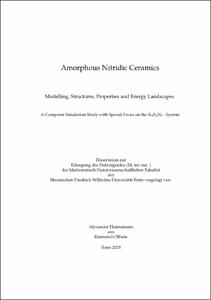Amorphous Nitridic CeramicsModelling, Structures, Properties and Energy Landscapes ; A Computer Simulation Study with Special Focus on the Si3B3N7-system

Amorphous Nitridic Ceramics
Modelling, Structures, Properties and Energy Landscapes ; A Computer Simulation Study with Special Focus on the Si3B3N7-system

| dc.contributor.advisor | Schön, J. Christian | |
| dc.contributor.author | Hannemann, Alexander | |
| dc.date.accessioned | 2020-04-06T13:00:49Z | |
| dc.date.available | 2020-04-06T13:00:49Z | |
| dc.date.issued | 2003 | |
| dc.identifier.uri | https://hdl.handle.net/20.500.11811/1966 | |
| dc.description.abstract | One of the most fascinating new classes of materials for high-temperature applications are the multinary amorphous nitrides and carbides such as amorphous silicon boron nitride (a- Si3B3N7) and a-SiBN3C. Similarly, for optical applications compounds in the amorphous Si/O/N-system have been suggested. However, due to the amorphous nature of these materials, the details of their structure are inaccesible via conventional X-ray or neutron diffraction. Furthermore, for technical applications it is important to know how these materials behave under extreme pressure and temperature conditions. Both, the difficulty of experimentally studying the microscopic properties of such materials and their behaviour at extreme thermodynamic conditions, lead to the neccessity of employing computer simulations in order to investigate the properties of these materials. In this thesis, two new methods for the modelling of amorphous structures are presented. The first one mimicks the sol-gel route typically employed in the experimental synthesis of the nitridic ceramics. This modelling method takes into account different reaction rates for elementary reactions occuring in the sol-gel process, and it can be adapted to different materials. The method is applied to a-Si3B3N7 and it successfully reproduces all experimental data (density, pair correlation function, short and medium range order), thus showing that the reaction rates of elementary reactions need to be taken into account for a proper modelling of these materials. The second approach, the random-close packing (RCP) approach allows one to very quickly generate models of amorphous substances, with only limited knowledge about the local environments of the atoms. The RCP method has been successfully applied to the modelling of amorphous B2O3, SiO2 and Si3N4. Furthermore, employing the RCP approach to the Si/O/N-system for a range of compositions, the structural properties of the Si/O/N system have been investigated, and the calculated models favourably compare with the available experimental data. Furthermore, for a-Si3B3N7 it is shown, that structural models generated along different routes on the computer (representing different experimental synthesis routes) lead to clearly distinguishable structural models. One finds the best agreement with experiment for those models that follow the actual synthesis route as closely as possible. To understand the behaviour of Si3B3N7 under extreme pressure and temperature conditions, the phase diagram over large ranges of temperatures and volumes has been determined. Based on the simulation, a-Si3B3N7 exhibits both aging behaviour and a glass transition. The analysis of the energy landscape of a-Si3B3N7 shows that this landscape is similar to those of simple Lennard-Jones model system, which have been studied theoretically in the context of the glass transition. | |
| dc.language.iso | eng | |
| dc.rights | In Copyright | |
| dc.rights.uri | http://rightsstatements.org/vocab/InC/1.0/ | |
| dc.subject | Ceramics | |
| dc.subject | Nitrides | |
| dc.subject | Computer Simulation | |
| dc.subject | Modelling | |
| dc.subject | Energy Landscapes | |
| dc.subject | LGING | |
| dc.subject | Glasses | |
| dc.subject.ddc | 540 Chemie | |
| dc.title | Amorphous Nitridic Ceramics | |
| dc.title.alternative | Modelling, Structures, Properties and Energy Landscapes ; A Computer Simulation Study with Special Focus on the Si3B3N7-system | |
| dc.type | Dissertation oder Habilitation | |
| dc.publisher.name | Universitäts- und Landesbibliothek Bonn | |
| dc.publisher.location | Bonn | |
| dc.rights.accessRights | openAccess | |
| dc.identifier.urn | https://nbn-resolving.org/urn:nbn:de:hbz:5n-03121 | |
| ulbbn.pubtype | Erstveröffentlichung | |
| ulbbnediss.affiliation.name | Rheinische Friedrich-Wilhelms-Universität Bonn | |
| ulbbnediss.affiliation.location | Bonn | |
| ulbbnediss.thesis.level | Dissertation | |
| ulbbnediss.dissID | 312 | |
| ulbbnediss.date.accepted | 29.09.2003 | |
| ulbbnediss.fakultaet | Mathematisch-Naturwissenschaftliche Fakultät | |
| dc.contributor.coReferee | Beck, Johannes |
Files in this item
This item appears in the following Collection(s)
-
E-Dissertationen (4114)




